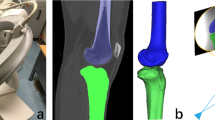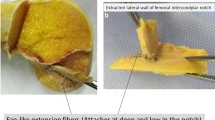Abstract
Purpose
The purpose of this study is twofold: first, to visualize both the tibial and femoral bony insertion surfaces and second, to describe the anterior cruciate ligament (ACL) geometrically, using novel 3D CT imaging. In addition, new concepts of best-fit cylinder and central axis are introduced and evaluated.
Methods
Eight unpaired knees of embalmed cadavers were used in this study. Following the dissection process, the ACL was injected with a contrast medium for CT imaging. The obtained CT images in extension, 45°, 90° and full flexion were segmented and rendered in 3D allowing morphological and morphometric analysis of the ACL. Anatomical footprint centres, femoral and tibial footprint surface area, best-fit ACL-cylinder intersection area, best-fit ACL-cylinder/footprint coverage ratio, best-fit ACL-cylinder central axis projections at the tibial and femoral footprint in the four positions were used to describe the anatomy of the ACL, based on the Bernard, Hertel and Amis grid.
Results
Based on these parameters, with the best-fit cylinder representing the bulk of the ACL, a changing fibre-recruitment pattern was seen with a moving position of the central axis from posterior to anterior on the femoral and tibial footprint, going from extension to flexion. Furthermore, the numerical data show an increase in tibial footprint coverage by the best-fit cylinder through the ACL when the knee is progressively flexed, whereas an inverse relationship was seen on the femoral side.
Conclusion
This study is the first to describe the detailed anatomy of the human ACL with respect to its course and footprints using a 3D approach. It confirms the large difference and inter-patient variability between the tibial and femoral footprint area with the former being significantly smaller. The best-fit cylinder concept illustrates the recruitment pattern of the native ACL where in extension the postero-lateral fibres are recruited and in flexion rather the antero-medial bundle, which can be valuable information in reconstructive purposes. The best-fit cylinder and central axis concept offers additional insights into the optimal tunnel placement at the tibial and femoral footprint in order to cover the largest portion of the native ACL soft tissue, aiming for optimal ACL reconstruction.





Similar content being viewed by others
References
Amis A, Jakob R (1998) Anterior cruciate ligament graft positioning, tensioning and twisting. Knee Surg Sports Traumatol Arthrosc 6:S2–S12
Bernard M, Hertel P, Hornung H, Cierpinski T (1997) Femoral insertion of the ACL. Radiographic quadrant method. Am J Knee Surg 10:14–22
Chambat P, Guier C, Sonnery-Cottet B, Fayard J-M, Thaunat M (2013) The evolution of ACL reconstruction over the last fifty years. Int Orthop 37:181–186
Dargel J, Pohl P, Tzikaras P et al (2006) Morphometric side-to-side differences in human cruciate ligament insertions. Surg Radiol Anat 28:398–402
De Maeseneer M, Jager T, Vanderdood K, Van Roy P, Shahabpour M, Marcelis S (2003) Ultrasound during dissection of cadaveric specimens: a new method for obtaining ultrasound-anatomic correlations in musculoskeletal radiology. Eur Radiol 14:870–874
Feigl G, Fuchs A, Gries M, Hogan QH, Weninger B, Rosmarin W (2006) A supraomohyoidal plexus block designed to avoid complications. Surg Radiol Anat 28:403–408
Ferretti M, Ekdahl W, Shen W et al (2007) Osseous landmarks of the femoral attachment of the anterior cruciate ligament: an anatomic study. Arthroscopy 23:1218–1225
Forsythe B, Harner C, Martins CA, Shen W, Lopes OV Jr, Fu FH (2009) Topography of the femoral attachment of the posterior cruciate ligament. Surgical technique. J Bone Joint Surg Am 91(1):89–100
Frobell R, Roos H, Roos E, Roemer F, Ranstam J, Lohmander S (2013) Treatment for acute anterior cruciate ligament tear: five year outcome of randomized trial. BMJ 346–353: doi:10.1136/bmj.f232
Groscurth P, Eggli P, Kapfhammer J, Rager G, Hornung JP, Fasel JDH (2001) Gross anatomy in the surgical curriculum in Switzerland: improved cadaver preservation, anatomical models, and course development. Anat Rec (New Anat) 265:254–256
Hara K, Mochizuki T, Sekiya I, Yamaguchi K, Akita K, Muneta T (2009) Anatomy of normal human anterior cruciate ligament attachments evaluated by divided small bundles. Am J Sports Med 37:2386–2391
Harner CD, Baek GH, Vogrin TM, Carlin GJ, Kashiwaguchi S, Woo SL (1999) Quantitative analysis of human cruciate ligament insertions. Arthroscopy 15:741–749
Hwang M, Piefer J, Lubowitz J (2012) Anterior cruciate ligament tibial footprint anatomy: systematic review of the 21st century literature. Arthroscopy 28:728–734
Inderdaug E, Larsen A, Strand T et al (2016) The effect of feedback from post-operative 3D CT on placement of femoral tunnels in single-bundle anatomic ACL reconstruction. Knee Surg Sports Traumatol Arthrosc 24(1):154–160
Kato Y, Maeyama A, Lertwanich P, Wang J, Ingham S, Kramer S, Martins C, Smolinski P, Fu F (2014) Biomechanical comparison of different graft positions for single-bundle anterior cruciate ligament reconstruction. Knee Surg Sports Traumatol Arthrosc 21:816–823
Luites JW, Wymenga AB, Blankevoort L et al (2007) Description of the attachment geometry of the anteromedial and posterolateral bundles of the ACL from arthroscopic perspective for anatomical tunnel placement. Knee Surg Sports Traumatol Arthrosc 15:1422–1431
McCullough K, Phelps K, Spindler K, Matava M, Dunn W, Parker R, Reinke E (2012) Return to high school- and college-level football after anterior cruciate ligament reconstruction. Am J Sports Med 40:2523–2529
Muneta T, Takakuda K, Yamamoto H (1997) Intercondylar notch width and its relation to the configuration and cross-sectional area of the anterior cruciate ligament. A cadaveric knee study. Am J Sports Med 25:69–72
Norris R, Thompson P, Getgood A (2012) The effect of anterior cruciate ligament reconstruction on the progression of osteoarthritis. Open orthop J 6:506–510
Pfirrmann CW, Oberholzer PA, Zanetti M, Boos N, Trudell DJ, Resnick D, Hodler J (2001) Selective nerve root blocks for the treatment of sciatica: evaluation of injection site and effectiveness. A study with patients and cadavers. Radiology 221:704–711
Piefer J, Pflugner R, Hwang M, Lubowitz J (2012) Anterior cruciate ligament femoral footprint anatomy: systematic review of the 21st century literature. Arthroscopy 28:872–881
Rahr-Wagner L, Thillemann T, Pedersen A, Lind M (2013) Increased risk of revision after anteromedial compared with transtibial drilling of the femoral tunnel during primary anterior cruciate ligament reconstruction: results from the Danish knee ligament Reconstruction register. Arthroscopy 29:98–105
Robbrecht C, Claes S, Cromheecke M et al (2014) Reliability of a semi-automated 3D-CT measuring method for tunnel diameters after anterior cruciate ligament reconstruction: a comparison between soft-tissue single-bundle allograft vs. autograft. Knee 21(5):926–931
Siebold R, Ellert T, Metz S et al (2008) Femoral insertions of the anteromedial and posterolateral bundles of the anterior cruciate ligament: morphometry and arthroscopic orientation models for double-bundle bone tunnel placement—a cadaveric study. Arthroscopy 24:585–592
Siebold R, Ellert T, Metz S et al (2008) Tibial insertions of the anteromedial and posterolateral bundles of the anterior cruciate ligament: morphometry, arthroscopic landmarks, and orientation model for bone tunnel placement. Arthroscopy 24:145–161
Smigielski R, Zdanowicz U, Drwiega M et al (2015) Ribbon like appearance of the midsubstance fibres of the anterior cruciate ligament close to its femoral insertion site: a cadaveric study including 111 knees. Knee Surg Sports Traumatol Arthrosc 23(11):3143–3150
Staubli H, Rauschning W (1994) Tibial attachment area of the anterior cruciate ligament in the extended knee position. Anatomy and cryosections in vitro complemented by magnetic resonance arthrography in vivo. Knee Surg Sports Traumatol Arthrosc 2:138–146
Struewer J, Ziring E, Frangen TM, Efe T, Meißner S, Buecking B, Bliemel C, Bernd Ishaque (2013) Clinical outcome and prevalence of osteoarthritis after isolated anterior cruciate ligament reconstruction using hamstring graft: follow-up after two and ten years. Int Orthop 37:271–277
Tajima G, Nozaki M, Iriuchishima T, Ingham SJ, Shen W, Smolinski P, Fu FH (2009) Morphology of the tibial insertion of the posterior cruciate ligament. J Bone Joint Surg Am 91(4):859–866
Takahashi M, Doi M, Abe M, Suzuki D, Nagano A (2006) Anatomical study of the femoral and tibial insertions of the anteromedial and posterolateral bundles of human anterior cruciate ligament. Am J Sports Med 34:787–792
Takahashi M, Matsubara T, Doi M, Suzuki D, Nagano A (2006) Anatomical study of the femoral and tibial insertions of the anterolateral and posteromedial bundles of human posterior cruciate ligament. Knee Surg Sports Traumatol Arthrosc 14:1055–1059
Taketomi S, Inui H, Nakamura K et al (2014) Clinical outcome of anatomic double-bundle ACL reconstruction and 3D CT model-based validation of femoral socket aperture position. Knee Surg Sports Traumatol Arthrosc 22(9):2194–21201
Tsukada H, Ishibashi Y, Tsuda E, Fukuda A, Toh S (2008) Anatomical analysis of the anterior cruciate ligament femoral and tibial footprints. J Orthop Sci 13:122–129
Van der Bracht H, Bellemans J, Victor J, Page B, Verdonk P (2014) Can a tibial tunnel in ACL surgery be placed anatomically without impinging on the femoral notch? A risk factor analysis. Knee Surg Sports Traumatol Arthrosc 22(2):291–297
Van der Bracht H, Verhelst L, Stuyts B, Page B, Bellemans J, Verdonk P (2014) Anatomic single-bundle ACL surgery: consequences of tibial tunnel diameter and drill-guide angle on tibial footprint coverage. Knee Surg Sports Traumatol Arthrosc 22(5):1030–1039
Van Hoof T, Cromheecke M, Tampere T, D’herde K, Victor J, Verdonk P (2013) The posterior cruciate ligament: a study on its bony and soft tissue anatomy using novel 3D CT technology. Knee Surg Sports Traumatol Arthrosc 21:1005–1010
Van Hoof T, Gomes GT, Audenaert E, Verstraete K, Kerckaert I, D’Herde K (2008) 3D computerized model for measuring strain and displacement of the brachial plexus following placement of reverse shoulder prosthesis. Anat Rec (Hoboken) 291:1173–1185
Yamamoto Y, Hsu WH, Woo SL, Van Scyoc AH, Takakura Y, Debski RE (2004) Knee stability and graft function after anterior cruciate ligament reconstruction: a comparison of a lateral and anatomical femoral tunnel placement. Am J Sports Med 32:1825–1832
Zantop T, Herbort M, Raschke MJ et al (2007) The role of the anteromedial and posterolateral bundles of the anterior cruciate ligament in anterior tibial translation and internal rotation. Am J Sports Med 35:223–227
Zantop T, Petersen W, Sekiya J, Musahl V, Fu F (2006) Anterior cruciate ligament anatomy and function relating to anatomical reconstruction. Knee Surg Sports Traumatol Arthrosc 14:982–992
Author information
Authors and Affiliations
Corresponding author
Ethics declarations
Conflict of interest
The authors declare that they have no conflict of interest.
Funding
No funding was received for this study.
Ethical approval
In these testaments is stated that the human body can be implemented in educational or research programs with no further specification. The body donation program guarantees high ethical standards during implementation of the human body in the different projects.
Informed consent
In the Ghent Anatomical Facility informed consent for anatomical study is given as people voluntary sign up for the body donation program.
Rights and permissions
About this article
Cite this article
Tampere, T., Van Hoof, T., Cromheecke, M. et al. The anterior cruciate ligament: a study on its bony and soft tissue anatomy using novel 3D CT technology. Knee Surg Sports Traumatol Arthrosc 25, 236–244 (2017). https://doi.org/10.1007/s00167-016-4310-z
Received:
Accepted:
Published:
Issue Date:
DOI: https://doi.org/10.1007/s00167-016-4310-z




